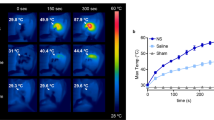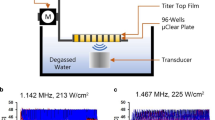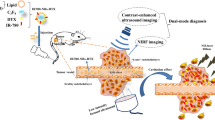Abstract
Purpose
This study aims to demonstrate that pulsed high-intensity focused ultrasound (pulsed-HIFU) may enhance the fructose-conjugated 4-borono-L-phenylalanine (BPA-Fr) accumulation in tumor lesion using 18F-FBPA-Fr microPET scans.
Procedures
To the mice bearing orthotopic SASC03 human tongue squamous carcinoma xenograft, a 2-min pulsed-HIFU was applied to tumor. Immediately after pulsed-HIFU treatment, 18F-FBPA-Fr was intravenously injected, and biological characterizations including microPET imaging and biodistribution were conducted.
Results
Both biodistribution studies and microPET imaging performed after intravenous injection of 18F-FBPA-Fr revealed higher tumor uptake in HIFU-treated mice than that of the control. CD31 and Ki-67 histochemical staining of tumor sections and H&E staining of nearby normal tissues revealed no significant difference between the pulsed-HIFU-treated mice and the control.
Conclusion
This study demonstrated that pulsed-HIFU was beneficial to the accumulation of boron drug in the head and neck tumor lesion and may enhance the therapeutic efficacy of clinical BNCT.



Similar content being viewed by others
References
Hatanaka H, Nakagawa Y (1994) Clinical results of long-surviving brain tumor patients who underwent boron neutron capture therapy. Int J Radiat Oncol Biol Phys 28:1061–1066
Kato I, Ono K, Sakurai Y et al (2004) Effectiveness of BNCT for recurrent head and neck malignancies. Appl Radiat Isot 61:1069–1073
Yoshino K, Suzuki A, Mori Y et al (1989) Improvement of solubility of p-boronophenylalanine by complex formation with monosaccharides. Strahlenther Onkol 165:127–129
Hsieh CH, Chen YF, Chen FD et al (2005) Evaluation of pharmacokinetics of 4-borono-2-18F-fluoro-L-phenylalanine for boron neutron capture therapy in a glioma-bearing rat model with hyperosmolar blood–brain barrier disruption. J Nucl Med 46:1858–1865
Wang HE, Liao AH, Deng WP et al (2004) Evaluation of 4-borono-2-18F-fluoro-L-phenylalanine-fructose as a probe for boron neutron capture therapy in a glioma-bearing rat model. J Nucl Med 45:302–308
Kennedy JE (2005) High-intensity focused ultrasound in the treatment of solid tumors. Nat Rev Cancer 5:321–327
Dromi S, Frenkel V, Luk A et al (2007) Pulsed-high-intensity focused ultrasound and low-temperature-sensitive liposomes for enhanced targeted drug delivery and antitumor effect. Clin Cancer Res 13:2722–2727
Poff JA, Allen CT, Traughber B et al (2008) Pulsed high-intensity focused ultrasound enhances apoptosis and growth inhibition of squamous cell carcinoma xenografts with proteasome inhibitor bortezomib. Radiology 248:485–491
Lemaire C, Damhaut P, Lauricekka B et al (2002) Fast [18F]FDG synthesis by alkaline hydrolysis on a low polarity solid-phase support. J Label Compd Radiopharm 45:435–447
Tournier I, Bernuau D, Poliard A et al (1987) Detection of albumin mRNAs in rat liver by in situ hybridization: usefulness of paraffin embedding and comparison of various fixation procedures. J Histochem Cytochem 35:453–459
Kankaanranta L, Seppala T, Koivunoro H et al (2007) Boron neutron capture therapy in the treatment of locally recurred head and neck cancer. Int J Radiat Oncol Biol Phys 69:475–482
Wang S, Shin IS, Hancock H et al (2012) Pulsed high-intensity focused ultrasound increases penetration and therapeutic efficacy of monoclonal antibodies in murine xenograft tumors. J Control Release 162:218–224
Khaibullina A, Jang B, Sun H et al (2008) Pulsed high-intensity focused ultrasound enhances uptake of radiolabeled monoclonal antibody to human epidermoid tumor in nude mice. J Nucl Med 49:295–302
Lin CY, Li JR, Tseng HC et al (2012) Enhancement of focused ultrasound with microbubbles on the treatments of anticancer nanodrug in mouse tumors. Nanomedicine 8:900–907
Ranjan A, Jacobs GC, Woods DL et al (2012) Image-guided drug delivery with magnetic resonance-guided high-intensity focused ultrasound and temperature sensitive liposomes in a rabbit Vx2 tumor model. J Control Release 158:487–494
Maruyama K, Ishida O, Kasaoka S et al (2004) Intracellular targeting of sodium mercaptoundecahydrododecaborate (BSH) to solid tumors by transferrin-PEG liposomes for boron neutron-capture therapy (BNCT). J Control Release 98:195–207
Feng B, Tomizawa K, Michiue H et al (2009) Delivery of sodium borocaptate to glioma cells using immunoliposome conjugated with anti-EGFR antibodies by ZZ-His. Biomaterials 30:1746–1755
Sumitani S, Oishi M, Yaguchi T et al (2012) Pharmacokinetics of core-polymerized boron-conjugated micelles designed for boron neutron capture therapy for cancer. Biomaterials 33:3568–3577
Yinghuai Z, Peng AT, Carpenter K et al (2005) Substituted carborane-appended water-soluble single-wall carbon nanotubes: new approach to boron neutron capture therapy drug delivery. J Am Chem Soc 127:9875–9880
Frenkel V, Kimmel E, Iger Y (2000) Ultrasound-induced intercellular space widening in fish epidermis. Ultrasound Med Biol 26:473–480
Watson KD, Lai CY, Qin S et al (2012) Ultrasound increases nanoparticle delivery by reducing intratumoral pressure and increasing transport in epithelial and epithelial–mesenchymal transition tumors. Cancer Res 72:1485–1493
Mesiwala AH, Farrell L, Wenzel HJ et al (2002) High-intensity focused ultrasound selectively disrupts the blood–brain barrier in vivo. Ultrasound Med Biol 28:389–400
Boucher Y, Baxter LT, Jain RK (1990) Interstitial pressure gradients in tissue-isolated and subcutaneous tumors: implications for therapy. Cancer Res 50:4478–4484
Acknowledgement
The authors thank the financial support from Taipei Veterans General Hospital, Taipei, Taiwan (V100A-045 and VGHUST101-G1-2-3). The authors also appreciate the technical support from the Taiwan Mouse Clinic which is funded by the National Research Program for Biopharmaceuticals (NRPB) at the National Science Council (NSC) of Taiwan.
Conflict of Interest
The authors declare that they have no conflict of interest.
Author information
Authors and Affiliations
Corresponding author
Additional information
Chun-Yi Wu and Pei-Chia Chan contributed equally to this work.
Rights and permissions
About this article
Cite this article
Wu, CY., Chan, PC., Chou, LS. et al. Pulsed-Focused Ultrasound Enhances Boron Drug Accumulation in a Human Head and Neck Cancer Xenograft-Bearing Mouse Model. Mol Imaging Biol 16, 95–101 (2014). https://doi.org/10.1007/s11307-013-0675-2
Published:
Issue Date:
DOI: https://doi.org/10.1007/s11307-013-0675-2




